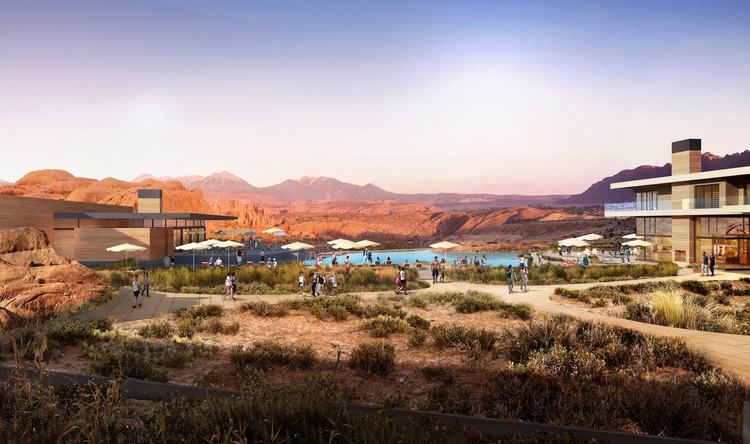Some information may be outdated.
If the Moab City Council votes in favor of a proposed agreement to amend a previously approved plan for the Lionsback Resort, council members fear it could subject the city to costly and drawn-out lawsuits.
To ensure that the city isn’t left footing the bill for any legal expenses, the council is asking the project’s team for assurances in writing that they will reimburse the city for any costs it might incur in the future.
The Moab City Council voted 4-0 on Tuesday, Feb. 14, to table consideration of a proposed zoning status agreement with developer LB Moab Land Co. LLC and Utah’s School and Institutional Trust Lands Administration (SITLA) until its next regular meeting on February 28; Heila Ershadi was not present for the vote.
Council members previously voted in December 2016 to postpone consideration of an agreement for the project, which includes plans for a 150-room resort hotel and – at full build-out – 188 residential lots on SITLA-owned property off Sand Flats Road.
Moab City Attorney Chris McAnany had suggested that the city could add a clause to the agreement stating that SITLA would reimburse the city for any reasonable litigation costs it might incur.
“It’s a relatively simple thing,” McAnany told the council on Feb. 14. “You could approve the agreement, subject to that condition.”
But Moab City Council member Kalen Jones said he wants that condition spelled out on paper before he votes on the proposal.
“I don’t have other concerns, but I’d like to see it in writing,” he said.
The city approved a preliminary agreement for the project in 2009, but opponents challenged a previous council’s 3-2 vote, and the legal dispute that followed took four years to work its way through the court system. The Utah Supreme Court ultimately declined to hear the case, allowing a lower court’s ruling in favor of the city and the developers to stand as is.
However, SITLA officials and the developer say the project stalled for 18 months during former Moab City Manager Rebecca Davidson’s administration.
Invent Development Partners co-founder and project developer Mike Badger told the council that he first approached city staffers with questions about a proposed plan amendment in October 2013 – when Donna Metzler was city manager – and their response was, “Please go forward.”
“We thought we were on the right track, and then Ms. Davidson came into the picture,” he said.
Badger said he began a dialogue with the former city manager, yet nothing ever happened during her time as the city’s top administrator.
“For a total of 14 months, we were trying to understand what the process was, and we just ran into a brick wall,” Badger said. “We didn’t get any answer from the city.”
SITLA Associate Director John Andrews said the project was floating around in a “black hole” for 18 months, although he declined to elaborate.
“I’m certainly not going to get into detail of what the issues were with the prior city manager,” he told the council. “We just want to express that what we’re trying to do is give the city as much control as it would have had anyway, but get this where we’re back on track and moving forward with our project.”
To get the project back on course, SITLA officials invoked an obscure state law that exempts state government agencies from municipal planning and zoning regulations.
McAnany previously informed the council that the agency would only agree to city jurisdiction on one condition: It wanted the city to classify changes it’s seeking as “minor” amendments, subject only to staff-level review, and not a more comprehensive public review.
The city attorney has maintained that the amendments are a major change because, in his interpretation of the plan, the size of the hotel has tripled, from a 50-room casita-style hotel, to a 150-room hotel.
“I opined in September of 2016 … that based on the change in the footprint of the buildings and the alignment of the buildings and structures, this would probably be a major change to the approved development plan, and hence would have to go through planning commission (and) city council review,” McAnany said. “There was disagreement from the developer and SITLA, and that’s where we are today.”
Andrews said that his agency wants to categorize the changes as minor plan amendments to “short-circuit” the possibility of multi-year litigation that seemingly dogs such projects in Grand County.
“We have got, from SITLA’s perspective, extreme reticence about going back into the full-on panoply of various planning commission and other public hearings – all providing the opportunity for third parties to drag us into another five years in the court system,” Andrews said.
In McAnany’s eyes, the latest zoning status agreement is an attempt to resolve the months-old dispute over the definition of minor versus major plan amendments.
“This agreement is a compromise document that, by definition as a compromise, nobody gets exactly what they want,” he said.
McAnany said that under the agreement, the developers will make changes to the project’s proposed wastewater system, which would consist of private sewer lines, as opposed to public ones. In response to concerns that council members and local residents have raised, McAnany said the developers will also make changes to their traffic studies of Sand Flats Road, while agreeing to conduct additional traffic studies at the end of the project’s first phase.
Andrews, meanwhile, said that project developers are trying to clarify wording in the agreement – specifically the references to the number of hotel rooms at the resort.
“We recognize that the documents have got ambiguity in them, and that’s part of what we’re looking to work out here,” he said.
However, he said he believes that the council has already had “a lot of opportunity” to amend the proposed agreement.
“I thought it came back with more red ink than black,” he said.
While Andrews maintains that the state’s code trumps any municipal zoning authority’s regulations, Moab City Council member Tawny Knuteson-Boyd questioned whether the city would be exposing itself to liability if it doesn’t follow its own laws.
“It’s a concern,” McAnany acknowledged. “We’re bound to follow our own codes, and when we depart from that, we do so at our peril.”
The zoning status agreement could resolve the dispute, he said, although it doesn’t insulate the city from third-party claims.
“There could be someone who disagrees with that, and anyone can file a lawsuit at any time,” McAnany said.
Moab City Council member Rani Derasary asked for more information about whether the reference to a minor change would set a precedent, noting that she hadn’t had time to adequately review the council’s Feb. 14 packet.
“I still feel like I need some time to absorb that, and some time to ask questions about precedent concerns,” she said.
As it is, Derasary said, she remains uneasy about the differing interpretations of the amendment that SITLA and the developers are seeking.
“I really am concerned about the difference between the major and the minor change,” she said.
Council members table consideration of resort’s zoning agreement
Appreciate the coverage? Help keep local news alive.
Chip in to support the Moab Sun News.





